In 2025, AuditBoard continues to be one of the most recognizable names in audit, risk, and compliance management, widely used by enterprises that need deep automation and strong SOX controls.
But when it comes to pricing, things aren’t nearly as straightforward.
Like many enterprise-grade GRC platforms, AuditBoard keeps its pricing behind the sales process, leaving many buyers wondering:
How much does it really cost, and what do you get for that investment?
With tighter budgets, growing compliance requirements, and a clear shift toward no-code, self-serve solutions, transparency now matters as much as capability.
Teams want to know not only if a platform is powerful, but whether it’s practical, scalable, and worth the spend.
In this guide, I’ll unpack everything currently known about AuditBoard’s pricing model, explore what drives its costs, and compare it to a modern, no-code alternative that delivers the same audit and compliance strength without the enterprise friction.
Let’s break it down and see whether AuditBoard truly delivers value for money in 2025.
TL;DR
- While AuditBoard offers strong audit automation, SOX compliance capabilities, and enterprise-level visibility, its pricing remains undisclosed and fully quote-based, with costs that often exceed $40K-$150K per year, depending on modules, users, and implementation scope.
- AI features are treated as add-ons, and other new or extended capabilities can drive that number even higher. While it delivers strong value for large, complex organizations, smaller and mid-market teams often find the model restrictive and expensive to maintain.
- SmartSuite offers a different path. It provides the same depth of audit, risk, and compliance functionality in a unified, no-code platform that’s easy to deploy, transparent in pricing, and built for agility. With plans starting at $12/user/month, a Free Forever plan, and a 14-day free trial, SmartSuite gives teams enterprise capability without enterprise overhead.
- For organizations that want to modernize their GRC programs with clarity, speed, and built-in AI, SmartSuite delivers the flexibility AuditBoard lacks at a fraction of the cost.
Does AuditBoard offer a free plan or trial?
Unlike many SaaS platforms that let you sign up and explore right away, AuditBoard keeps things a little more traditional.
There’s no instant sign-up, sandbox environment, or free trial you can use to test the software on your own.
Instead, access to AuditBoard starts with a sales-led demo.
Prospective customers need to schedule a walkthrough with the AuditBoard team, share details about their compliance needs, and then receive a tailored presentation of how the platform could fit their environment.

This means you can’t validate features, test usability, or benchmark against other tools without first going through the sales process.
AuditBoard pricing plans
Once you’ve gone through the demo process, pricing discussions with AuditBoard are handled entirely on a custom basis.
This means that there are no published tiers or self-serve pricing pages.
Instead, the company builds a quote around factors that probably include your organization’s size, scope, and compliance requirements (i.e., the modules you need).
This approach is typical of enterprise-grade GRC vendors, where every deployment can include different combinations of modules, integrations, and user types.
AuditBoard’s demo request form implies this to an extent, by requiring you to specify which GRC technology you need.
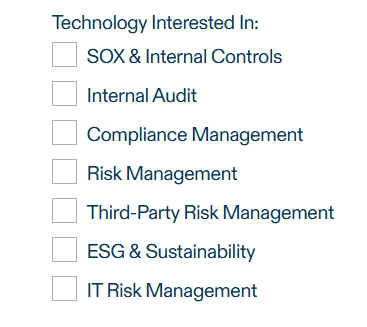
According to Vendr, however, there are four main modules within AuditBoard, each of which has two tiers:
- SOXHUB: Essentials and Professional.
- OpsAudit: Essentials and Professional.
- RiskOversight: Essentials and Professional.
- CrossComply: Essentials and Professional.
There’s no detailed data on what each module and tier includes, urging prospective users to schedule a demo for more information.
In short, it’s fair to say that AuditBoard’s pricing model is built for customization, not transparency.
It serves enterprises that expect tailored solutions, but for teams seeking predictable, upfront pricing, it may feel like a slower, more closed process compared to modern GRC platforms with published pricing and instant access.
How much does AuditBoard actually cost?
Because AuditBoard’s pricing is entirely quote-based, there’s no universal number to rely on, but several independent sources give us a fairly consistent picture of what teams typically pay in 2025.
According to Vendr’s marketplace data, which tracks recent real-world AuditBoard purchases, most contracts fall between $40,000 and $150,000 per year, depending on the modules, term length, and tier level selected.
For example:
- $148K for a 12-month subscription covering CrossComply Professional, OpsAudit Essentials, RiskOversight Professional, and SOXHUB Essentials (October 2025).
- $57K for a 30-month OpsAudit Essentials contract (August 2025).
- $125K and $105K for 36-month SOXHUB Professional subscriptions (December 2024).
- $42K for a 12-month SOXHUB Professional plan (December 2024).

Vendr’s benchmarks also highlight notable cost differences between tiers.
For instance, CrossComply Essentials starts around $32,800 annually, while SOXHUB Professional averages $48,200, which is roughly 47% higher.
User discussions echo that trend.
In one Reddit thread among internal audit professionals, a reviewer noted that their organization paid “around $150k for the first year, then $120k per year after renewal.”

That comment probably reflects the reality that first-year implementations often include onboarding and setup costs that inflate the initial spend.
These figures align with broader market estimates: enterprise deployments that combine multiple modules or include advanced features like ESG reporting and third-party risk oversight can easily cross six figures annually.
Initial setup costs, such as onboarding, configuration, and training, often add to the first-year spend.
Taken together, the data make one thing clear: AuditBoard sits at the premium end of the GRC software spectrum.
For large enterprises with mature audit programs, that investment can make sense.
But for smaller or mid-market teams seeking transparency, predictable pricing, and faster onboarding, the high entry point and opaque pricing structure can be a barrier.
Does AuditBoard provide good value for money in 2025?
AuditBoard continues to earn high praise from users who rely on it to manage complex audit and compliance operations.
They describe it as efficient, intuitive, and clearly built with auditors in mind, offering the right mix of structure, automation, and visibility for enterprise-scale programs.
Users also point out that workflows, reminders, and linked controls make it easier to stay on top of evidence collection and accountability, which remains one of AuditBoard’s biggest strengths.
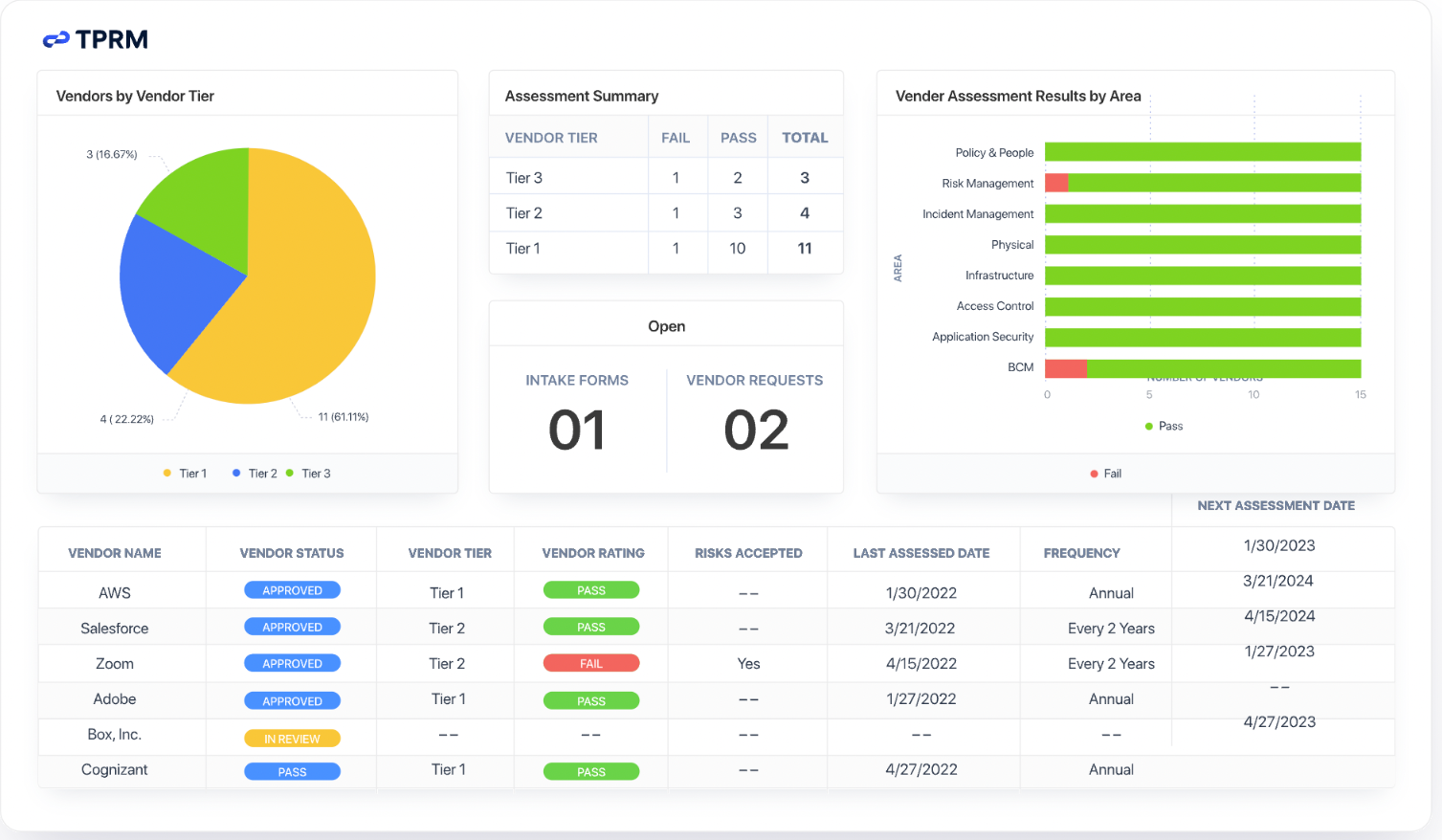
That said, the same flexibility and power that make AuditBoard a leader in the enterprise GRC space also contribute to its biggest challenges: complexity and cost.
- Implementation, while well-supported, can be lengthy and complex, particularly for teams without dedicated IT resources.
- Reporting and dashboard customization could be stronger, and some reviewers say that certain visual or aesthetic limitations make data analysis less flexible than expected.
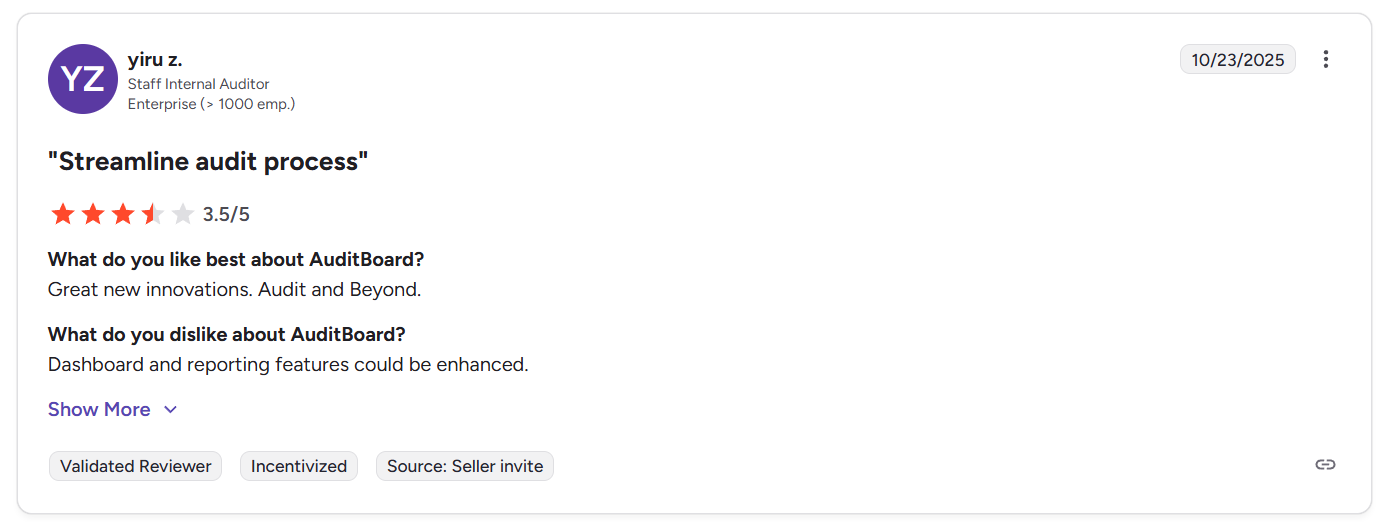
- Cost remains another recurring concern. A few users mention that new features, especially AI-driven capabilities, are often sold as paid add-ons rather than being included in existing packages.
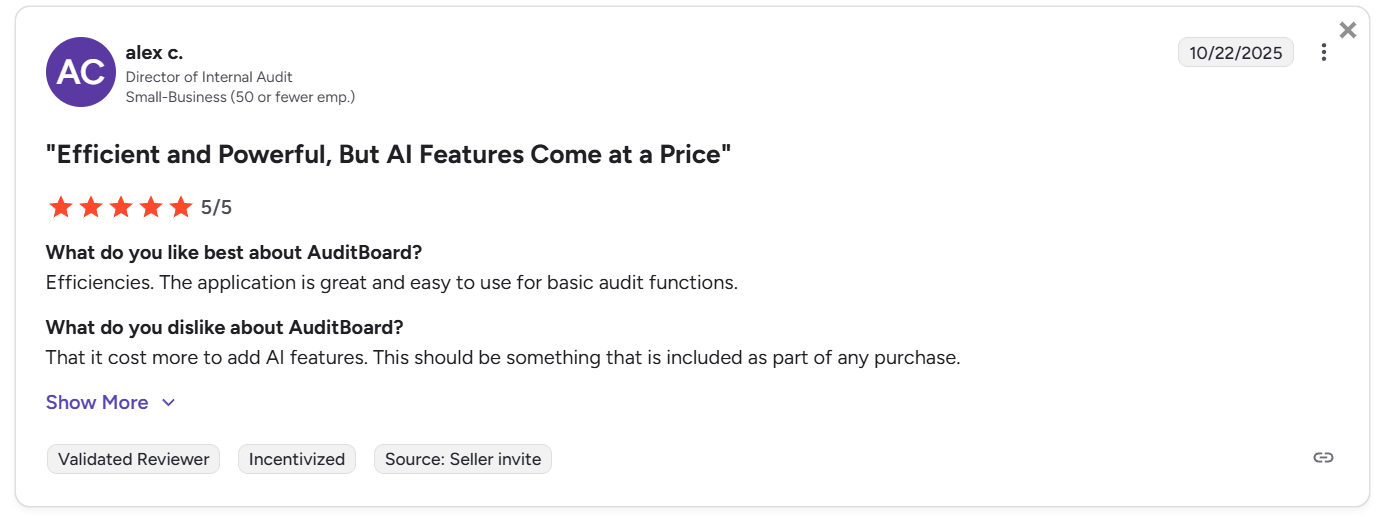

- Others note that while it’s a great fit for large enterprises, the pricing and scalability can feel excessive for smaller or mid-market teams.

So, does AuditBoard justify its premium pricing in 2025?
For big-budget enterprises managing complex frameworks like SOX, ISO, or SOC 2 across multiple entities, yes, as its depth and reliability are worth the price.
But for leaner teams or those looking for a faster, more agile rollout with transparent pricing, the total cost of ownership - and ongoing add-on fees - may outweigh the benefits.
Looking for an AuditBoard alternative?
Between premium pricing, complex onboarding, and costly feature upgrades, AuditBoard’s enterprise model can slow down even the best-run compliance teams.
The priorities have shifted.
Modern GRC leaders want tools that move as quickly as they do, being adaptable, data-driven, and ready to use from day one.
Basically, they want enterprise-grade capability, but not the enterprise overhead that often comes with it.
That’s exactly where SmartSuite fits in as an AuditBoard alternative.
It brings together the power of an advanced GRC platform with the accessibility and flexibility of a modern SaaS product, making it easy for teams of any size to build, automate, and manage audit and compliance workflows in one unified workspace.

Let’s look at some of its standout risk and compliance features.
1. Unified, no-code GRC platform
One of the biggest differences between AuditBoard and SmartSuite is how they’re built.
While AuditBoard divides its capabilities into separate modules - like SOXHUB for controls, OpsAudit for internal audits, and RiskOversight for enterprise risk - SmartSuite takes a unified approach.
Everything lives in one connected, no-code workspace.
That means your risk registers, controls, incidents, and audits aren’t managed in different silos or tabs.
They’re part of a single, fully integrated system where updates flow automatically between related processes.
So, when a risk changes status, the linked control, owner, and mitigation plan update instantly, with no manual syncing or duplicate entry.
Some of the key SmartSuite GRC capabilities include:
- Risk management: Identify, assess, and monitor risks with linked controls, scoring, and mitigation plans.
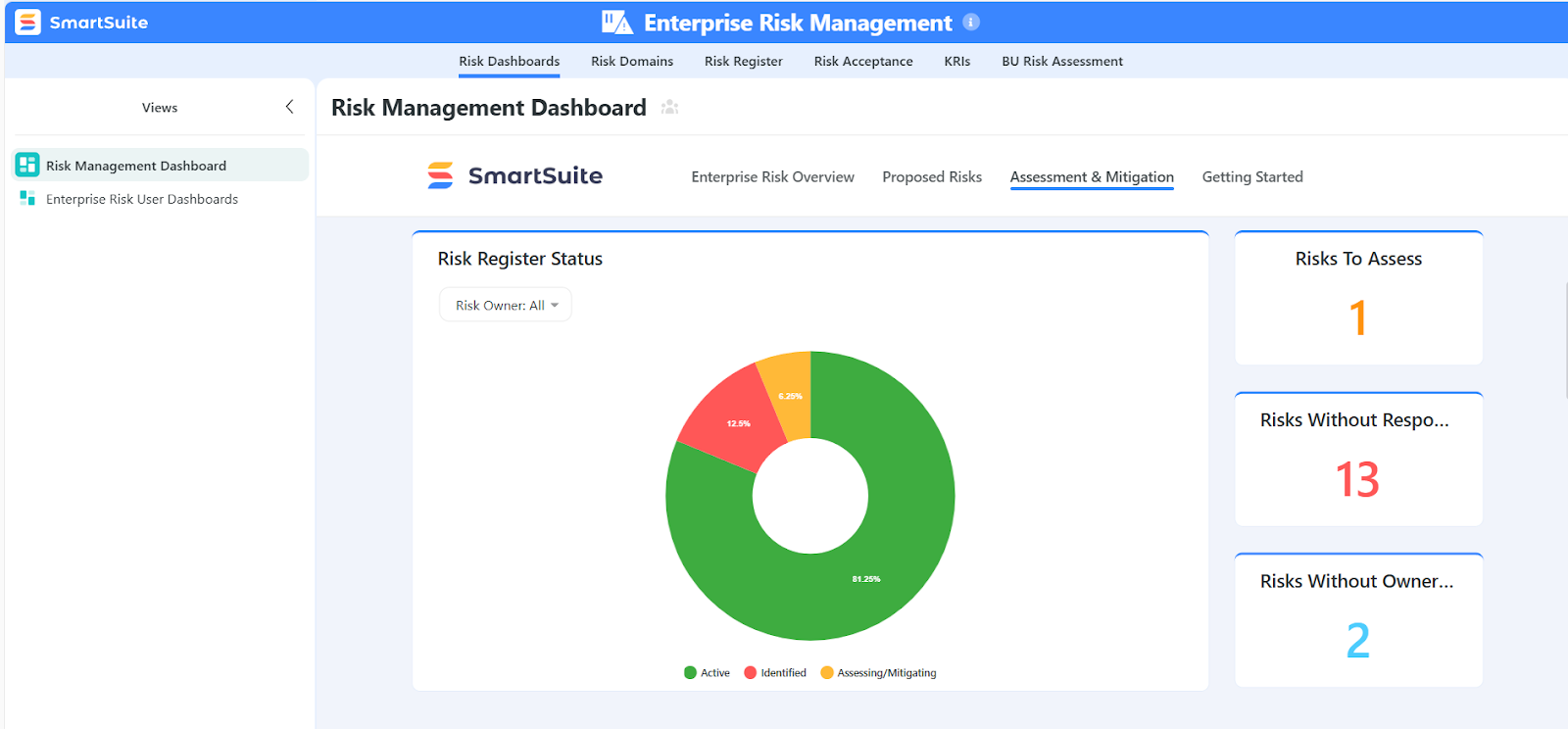
- Audit management: Plan, execute, and track internal audits, findings, and remediation activities end-to-end.
- Policy management: Centralize policies and procedures with full version control, approvals, and company-wide visibility.

- Incident management: Capture, assign, and resolve incidents with pre-built workflows and automatic escalation paths.
- Vendor & third-party risk: Evaluate vendor compliance, automate periodic reviews, and monitor ongoing risk exposure.
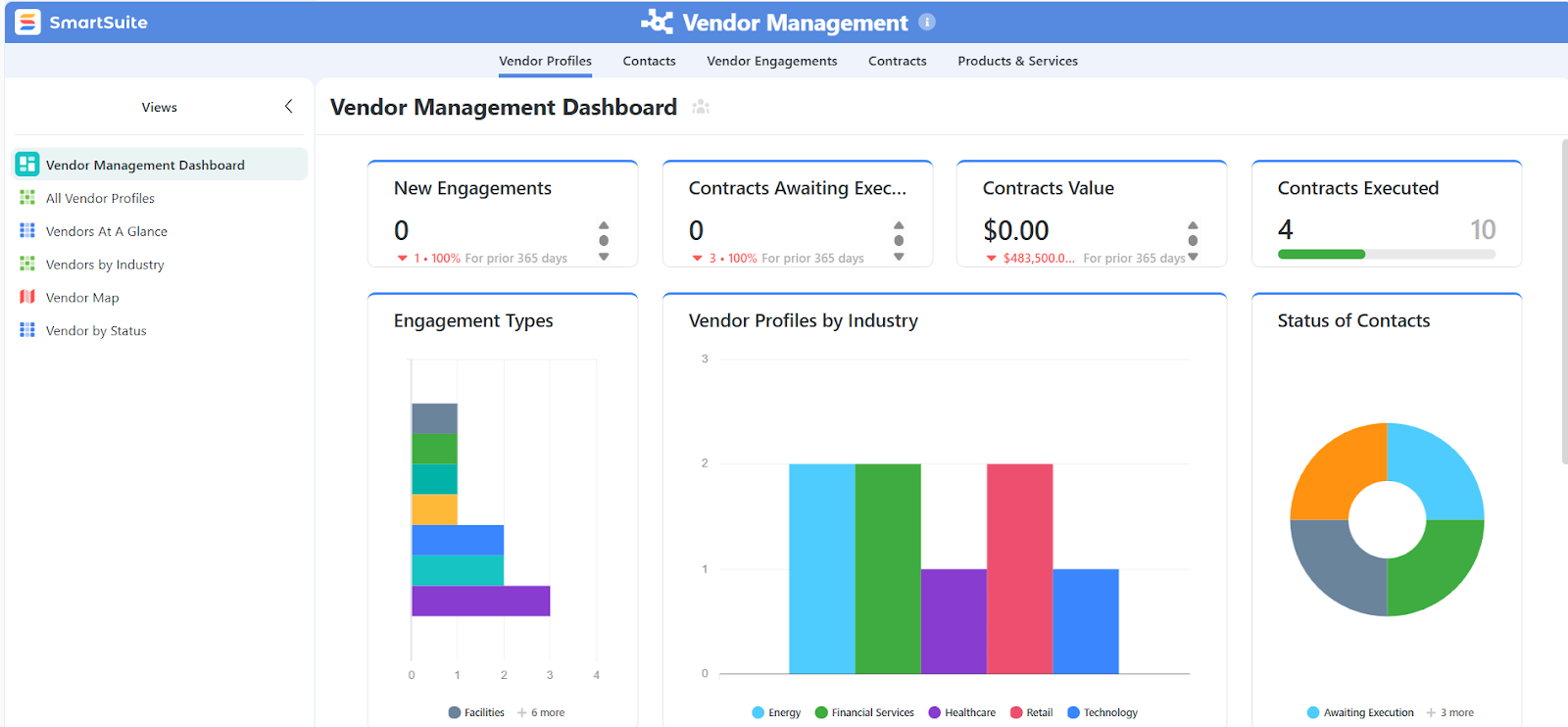
- Collaboration & accountability: Comment, tag colleagues, assign tasks, and track updates in real time, so every audit or risk owner stays aligned and accountable.

SmartSuite’s no-code flexibility also makes it easy for teams to adapt workflows on their own, without vendor intervention or IT support.
You can customize fields, dashboards, automations, and relationships between records to reflect your exact governance framework, whether you’re tracking SOX controls, ESG risks, or vendor audits.
This connected, flexible foundation is what makes SmartSuite stand out.
Instead of stitching together multiple modules or waiting on consultants to reconfigure reports, your entire GRC ecosystem lives under one roof: accessible, transparent, and tailored to the way your team works.
2. Ready-made templates and rapid deployment
One of the biggest pain points AuditBoard users mention is the time it takes to get up and running.
Implementations often stretch over weeks or months, requiring configuration support and scheduled onboarding sessions.
SmartSuite takes a completely different approach.
Instead of long rollouts, SmartSuite offers a library of ready-made, best-practice GRC templates designed to help teams start fast and customize freely.
Each template is fully interactive, meaning you can test, edit, and deploy it instantly, without needing developer or vendor involvement.
These templates cover a wide range of governance, risk, and compliance use cases, including:
- Vulnerability management: Mitigate the risk of security breaches and protect sensitive data from unauthorized access or theft.
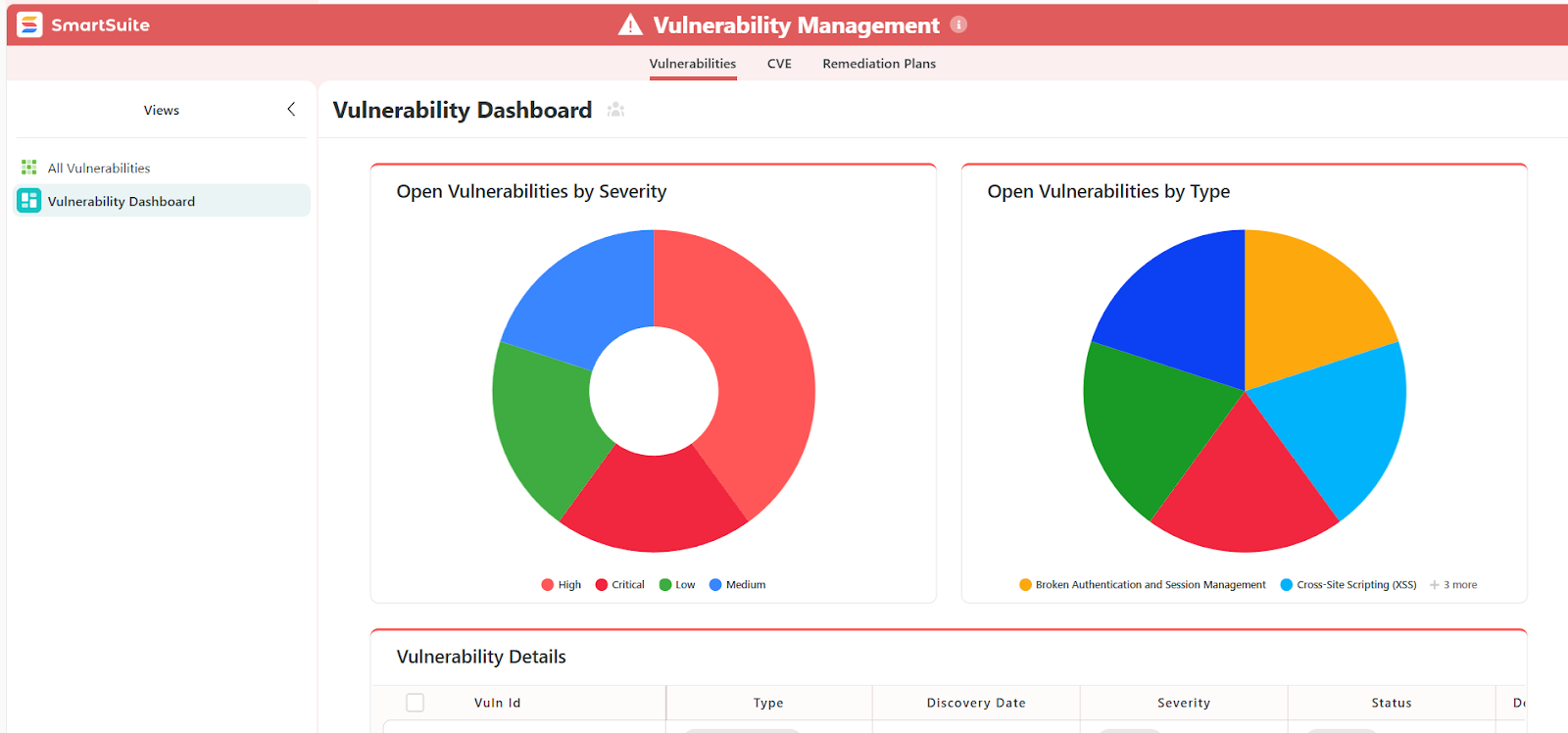
- Business continuity plans: Create, test, and adjust business continuity plans and disaster recovery tactics for various scenarios.
- Incident & issue management: Capture incidents as they occur, route them for resolution, and maintain a full audit trail.

- Regulatory change management: Track evolving regulations and document responses and policy updates in one place.
- ESG responsibility: Handle all sustainability requirements and drive sustainability programs at an organizational level from one point of control.

And because every SmartSuite template is no-code, you can adapt them instantly to your organization’s structure by adding custom fields, tweaking scoring formulas, linking to other solutions, or automating recurring tasks.
What typically takes weeks to configure in traditional GRC systems can be done in hours with SmartSuite.
3. Real-time reporting and analytics
One of the most common frustrations AuditBoard users mention is reporting flexibility, as its dashboards don’t provide as much flexibility as you would expect from an enterprise-grade platform.
SmartSuite was built to change that.
Every record, control, and risk in the platform updates in real time, feeding into dynamic dashboards and analytics that instantly reflect your latest data.
With SmartSuite, compliance and audit leaders can easily:
- Build custom dashboards that track KPIs like control effectiveness, audit progress, or open findings across departments.
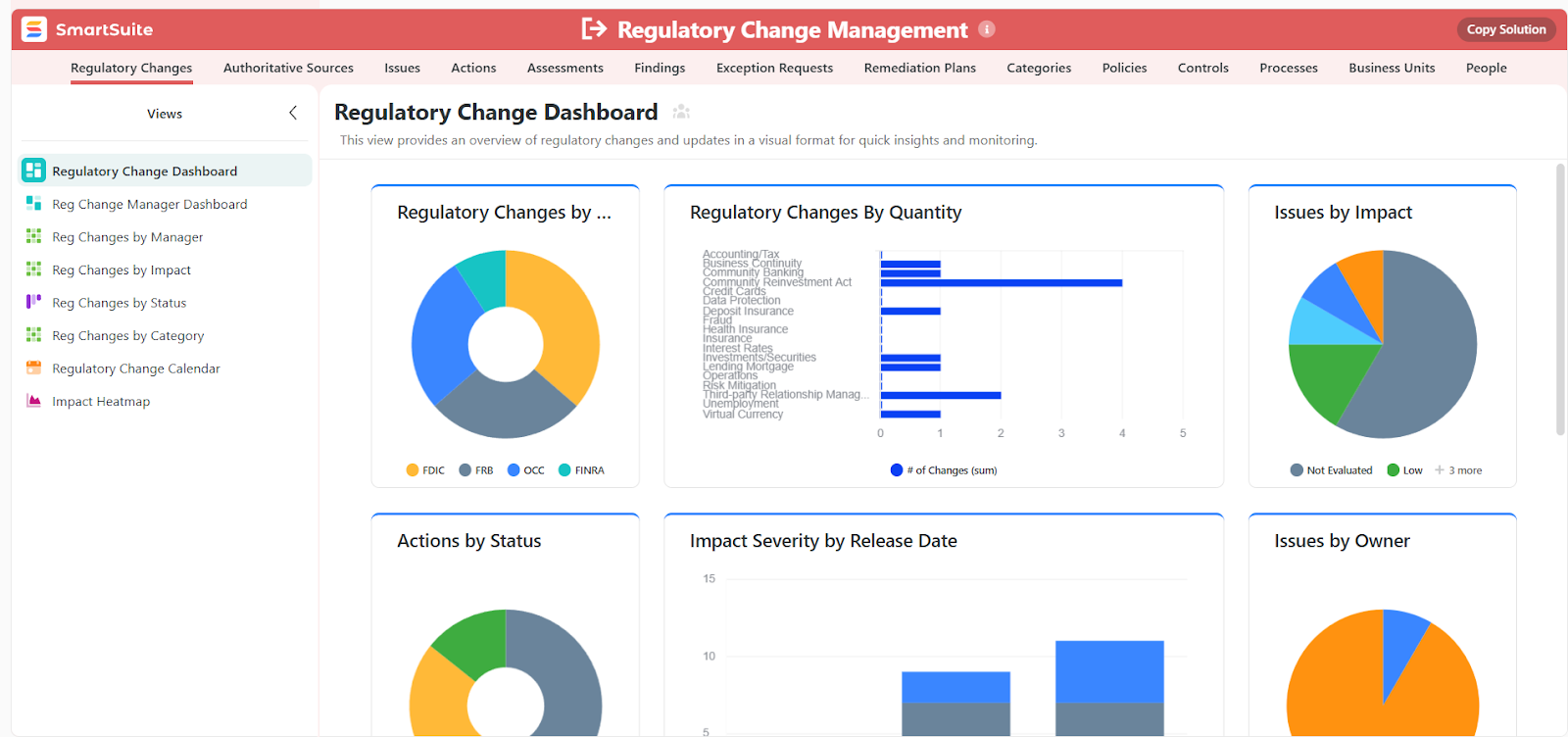
- Drill down into details directly from dashboards to see underlying records, ownership, and linked evidence.
- Automate scheduled reporting to deliver live compliance summaries to executives, auditors, or regulators without manual effort.
- Switch between multiple report views, such as Grid, Card, Kanban, Timeline, Calendar, or Dashboard, to visualize audit or risk data however it’s most useful.

- Export instantly to PDF, Excel, or Google Sheets when you need offline documentation or board-ready snapshots.
Because SmartSuite combines reporting, collaboration, and data management in one environment, everyone sees the same real-time picture, from risk owners and compliance officers to executives and external auditors.
The result is faster decisions, fewer blind spots, and complete visibility into your governance and risk posture without the complexity or delay of traditional GRC reporting tools.
4. Built-in automation and integrated AI
AuditBoard has recently begun introducing AI-driven enhancements, but many of these capabilities come at an additional cost, which many users feel is a massive drawback given the importance of AI today.
SmartSuite, on the other hand, includes SmartSuite AI - a fully integrated OpenAI-powered intelligence layer designed to streamline GRC workflows right out of the box - in all of its paid plans.
Because it’s built into the same no-code environment as your GRC data, AI can operate directly on the records, templates, and reports your team already uses.
Check out what SmartSuite AI is all about here:
Here’s how teams use SmartSuite AI and automation together to accelerate governance, risk, and compliance processes:
- AI-assisted audit documentation: Generate or refine audit findings, executive summaries, and control narratives automatically.

- Risk and issue analysis: Ask AI to summarize large volumes of risk data or categorize incidents based on impact and likelihood.
- Clarity and compliance review: Instantly polish policy drafts, risk reports, or internal communications for accuracy and readability.

- Automated workflows: Trigger notifications, approvals, or escalation paths whenever a risk score changes or a compliance deadline is missed.
The result is a modern GRC experience where automation and intelligence are built in instead of being sold separately, helping teams work faster, document smarter, and focus on strategy instead of repetitive tasks.
5. Enterprise-grade security and scalability
Security and reliability are non-negotiable in GRC, and SmartSuite is built with that understanding at its core.
While AuditBoard has long been trusted by large enterprises for its secure audit workflows, SmartSuite matches that same standard of protection while adding the agility today’s teams need.
Every SmartSuite workspace is built on a defense-in-depth architecture, ensuring sensitive governance and compliance data stays protected at every level, regardless of whether you’re a small compliance team or a global enterprise managing hundreds of risk owners across regions.
SmartSuite meets and exceeds the most recognized global standards, including:
- SOC 2 Type II, ISO 27701, GDPR, and HIPAA compliance.
- Encryption at rest and in transit for all customer data.
- Role-based access control (RBAC) to define permissions and prevent unauthorized access.

- Data loss prevention (DLP) and retention controls for added assurance.
- Regional data residency options for organizations that must comply with local data regulations.
- Comprehensive audit logs to track every action taken across your workspace.
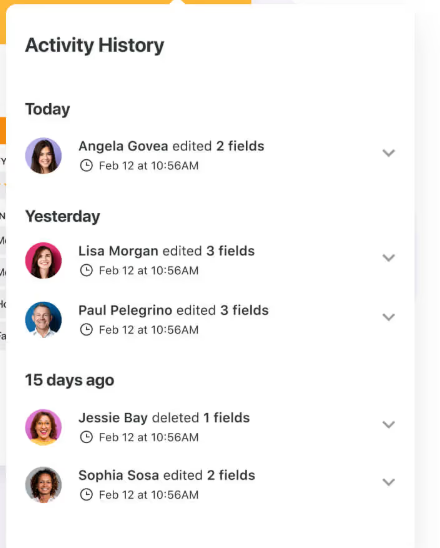
For larger deployments, SmartSuite scales seamlessly.
You can expand from a handful of users to thousands without re-architecting your system or waiting on vendor-led configuration.
In short, SmartSuite gives you enterprise-grade protection and performance without enterprise-grade friction.
You get the flexibility to grow, the compliance to satisfy auditors, and the peace of mind that your data is secure, wherever and however you scale.
How does SmartSuite’s pricing compare to AuditBoard’s?
Unlike AuditBoard, which keeps costs behind the sales process, SmartSuite lets you see exactly what you’ll pay from day one.
Whether you’re a small compliance team or a global enterprise, you can start free, test everything, and upgrade only when you’re ready.
The platform includes a Free Forever plan for individuals and small teams, offering access to core GRC templates, dashboards, real-time collaboration, and reporting features.
It supports up to 3 users, 5 solutions, and 1,000 records per solution, making it perfect for teams piloting SmartSuite’s GRC capabilities before a full rollout.
And when you’re ready to scale, SmartSuite’s four paid tiers expand seamlessly with your organization’s growth and compliance maturity:
- Team: $12/user/month, includes everything in Free, plus unlimited solutions, 5,000 records per solution, 50GB of file storage, advanced collaboration tools, and a 30-day recycle bin.
- Professional: $30/user/month, includes everything in Team, plus advanced permissions, two-factor authentication, Gmail & Outlook integrations, AI features, and 100GB of file storage.
- Enterprise: $45/user/month, includes everything in Professional, plus audit logs, data loss prevention, up to 50,000 monthly API calls, and 500GB of file storage.
- Signature: Custom pricing, a fully tailored plan with no predefined limits, including extended storage, API capacity, automations, and advanced enterprise security options such as SCIM provisioning and regional data residency.

Each of the first three paid plans offers a 14-day free trial with no credit card required, allowing teams to experience the platform’s full functionality - including SmartSuite AI and automation - before committing.
It’s a transparent, self-serve model that eliminates the hidden costs and drawn-out negotiations typical of legacy GRC vendors.
You can start instantly, test in real time, and scale at your own pace, all while knowing exactly what your investment will be.
How is SmartSuite different from AuditBoard?
While AuditBoard and SmartSuite both help organizations manage governance, risk, and compliance, the way they deliver value and the experience they provide couldn’t be more different.
AuditBoard reflects a traditional enterprise model: powerful, modular, and feature-rich, but locked behind custom quotes, lengthy implementations, and add-on pricing for capabilities like AI.
SmartSuite reimagines that experience entirely, bringing the same level of GRC depth into a modern, no-code platform that’s accessible, transparent, and designed for speed.
Here’s how the two platforms compare:
- Pricing transparency: AuditBoard follows a custom-quote model, meaning teams often don’t know total costs until late in the sales process. SmartSuite flips that approach with fully transparent, per-user pricing that starts at $12 per user/month, a Free Forever plan, and a 14-day free trial on all paid tiers. No negotiations, no surprises.
- Implementation speed: AuditBoard deployments typically involve guided evaluations and consultant-led onboarding. SmartSuite can be deployed the same day, complete with plug-and-play templates, drag-and-drop workflows, and automation out of the box.
- Customization and flexibility: AuditBoard offers configuration through its modular setup, but changes often require vendor assistance. SmartSuite gives teams full control through no-code customization, from custom fields and dashboards to automated workflows and AI-powered insights.
- AI and automation: AuditBoard’s AI capabilities are offered as paid upgrades. SmartSuite includes SmartSuite AI and workflow automation in all paid plans, helping teams accelerate audit documentation, summarize risks, and optimize policies automatically.
- Scalability: AuditBoard is ideal for large, established enterprises with dedicated compliance resources. SmartSuite scales from small teams to global organizations with the same enterprise-grade security and data residency options, but without the heavy lift or high entry cost.
In short, AuditBoard delivers impressive power, but SmartSuite delivers that same power faster, more affordably, and with total transparency.
For modern audit, risk, and compliance teams that value agility, collaboration, and clarity, SmartSuite is the clear alternative in 2025.
Final thoughts: Choosing the right GRC platform for 2025
AuditBoard’s structured workflows, automation depth, and reliability make it a strong choice for organizations with the time, resources, and budget to fully implement it.
However, in 2025, the GRC landscape has changed.
Teams no longer want complexity hidden behind quotes or long setup cycles. They want clarity, control, and scalability, but without sacrificing enterprise-grade functionality.
That’s where SmartSuite stands apart.
It combines everything modern GRC teams need, including risk management, audit tracking, compliance monitoring, automation, and AI, in one no-code, fully transparent platform that’s built for speed and collaboration.
You don’t have to wait months to get started. You don’t have to negotiate pricing. And you don’t need outside consultants to make it work.
SmartSuite gives you the tools to manage GRC faster, simpler, and with complete visibility.
So, if you’re ready to simplify GRC and focus on outcomes instead of overhead, start your free 14-day trial today and see why more teams are moving to SmartSuite in 2025.
Read more
- 10 Best Origami Risk Alternatives & Competitors In 2025 - Discover the top Origami Risk alternatives that deliver enterprise-grade GRC capabilities with faster deployment, simpler configuration, and transparent pricing.
- Protecht Pricing: Is It Worth It For GRC In 2025? - See how Protecht’s modular pricing model compares to modern, no-code GRC solutions that offer the same control and compliance power at a fraction of the cost.
- 10 Best Corporater Alternatives & Competitors In 2025 - Explore the leading Corporater competitors that combine performance, risk, and compliance management in more flexible, easy-to-use platforms built for today’s teams.
- SAP GRC Pricing: Is It Worth It In 2025? [Reviewed] - Find out whether SAP’s GRC suite still justifies its enterprise-level price tag, and which modern alternatives offer the same governance strength without the complexity.
- 10 Best Regulatory Change Management Software & Tools In 2025 - Stay ahead of evolving regulations with the top tools that simplify monitoring, automate impact assessments, and strengthen compliance workflows.
- Hyperproof Pricing: Is It Worth It In 2025? [Reviewed] - Uncover how Hyperproof’s pricing stacks up against agile, no-code GRC platforms that deliver faster compliance management and better scalability.

Run your entire business on a single platform and stop paying for dozens of apps
- Manage Your Workflows on a Single Platform
- Empower Team Collaboration
- Trusted by 5,000+ Businesses Worldwide















